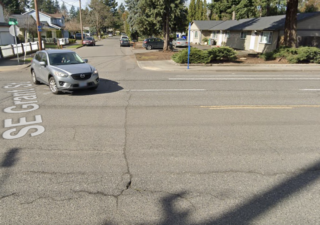The Portland Bureau of Transportation announced this week that the Southeast 162nd Ave Safety and Access to Transit Project will begin construction this summer.

The new design will leave people with three lanes to drive on instead of five. The reconfiguration gives PBOT room to vastly improve the safety of crossing the street to access transit stops and to create 14-foot wide bike lanes.
Unlike similar projects in east Portland, 162nd is not yet on PBOT’s ‘High Crash Network,’ a collection of streets and intersections where there are the most traffic deaths. As we shared back in 2019, the idea here is to tackle the problems proactively, instead of letting a dangerous situation spiral out of control.
The need to fix these aspects of 162nd was identified after TriMet added a new bus line serving the street (line 74) in 2018. TriMet installed bus stops at multiple points along the street where there aren’t crosswalks, making it unsafe and a hassle for people to get to their stop. PBOT says more than 6,000 drivers exceed the 35 miles per hour speed limit on this section of 162nd daily, a significant portion of whom are going more than 45 mph. Combined with a lack of sufficient crossings – there are only four on the entire 1.7 mile stretch – these high speeds are especially dangerous.
Advertisement
When this project is complete, there will be seven new crosswalks with concrete median islands to shorten crossing distances located at the Alder, Mill, Lincoln-Grant, Taggart, Tibbets, Haig and Rhone intersections.
The project will also improve street lighting and fix some sidewalks. The stretch of 162nd between Division and Powell will be repaved (the full project scope is from Powell to Stark).
Kem Marks, who was then the Director of Transportation Equity at the Rosewood Initiative, told BikePortland in 2019 he was glad PBOT was taking a proactive stance on this project.
“The purpose of this project is to make sure it doesn’t become [a high crash corridor],” Marks said at the time, adding that as east Portland grows in population, the chances for traffic injuries or fatalities increase, too.
This project is funded with $4,300,000 from the Fixing Our Streets program and $1,700,000 from TriMet via the transportation bill passed by the Oregon Legislature in 2017.


